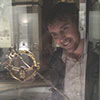The Early People gallery in the basement of the National Museum of Scotland is where to find fantastic beasts. These creatures emerged from the vivid imaginations of people living in Scotland over a thousand years ago. Some of them came from far away. Some are out in the open, while others are minute or hidden.
Many museum galleries have a code for how to find things. In the Early People gallery each glass case has a letter and a number code beginning at [A1] and, if you want to, you can follow the whole story through the alphabet up to [Y25]. There are four different colour-codes that tell you which of the four main themes of the gallery you are in and in each case there is also a map of Scotland and a timeline to show you where things were found and when they were made. Using this guide you will now be able to seek out fantastic beasts throughout the Early People gallery.
The focal point at the beginning of the Early People gallery is the back of the large Early Christian cross-slab from Hilton of Cadboll, Easter Ross [A5].
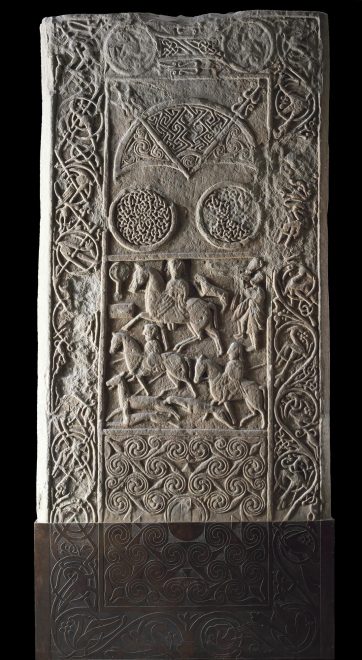
The hunting scene in the centre is one of the earliest examples of people in Scotland depicting human beings. This naturalistic art is surrounded by fantastic beasts in a vine-scroll border around the three square panels. The vine-scroll design originates in the Mediterranean where grapes grow, but there the design would be inhabited by naturalistic depictions of real animals such as birds and mice feasting on the fruit. Not here in Scotland though. The Picts who carved the Hilton stone preferred fantastic beasts with wings and lion-like bodies – griffins.

These were adapted from Mediterranean classical mythology, entangled in a plant that did not grow in Scotland, but in a strange way still celebrating the Christian religion which had established strong roots here by the eighth century AD.
The Picts also carved in stone a creature from their own mythical background. It is known as the Pictish beast and is one of a set group of symbols used as a unique system of communication by the Picts. This symbol system has not been deciphered and remains one of the real mysteries about the Picts. The Pictish beast can be seen above another hunting scene in the first section of the gallery, A Generous Land, (colour-coded green) on the back of a cross-slab from Scoonie, Fife [D8].
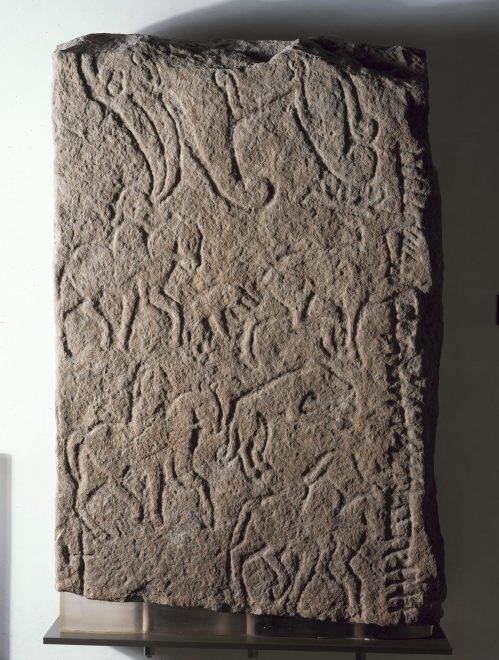
The Pictish beast has a long snout and some have called it an elephant, but the four legs end in spirals. Mixing features of land and water creatures, the Pictish beast is a hybrid whose origins are obscure. Some have tried to identify it as a whale or porpoise, while others have suggested it may be a creature later recorded in Scottish folktales as the Kelpie, the water horse.
In the second theme of the gallery, Wider Horizons, (colour-coded blue), we learn about Early People’s connections with the world beyond Scotland. A bronze griffin-mount from the second century AD Roman fort of Strageath [P4] shows how fantastic beasts from classical mythology were first brought to Scotland.
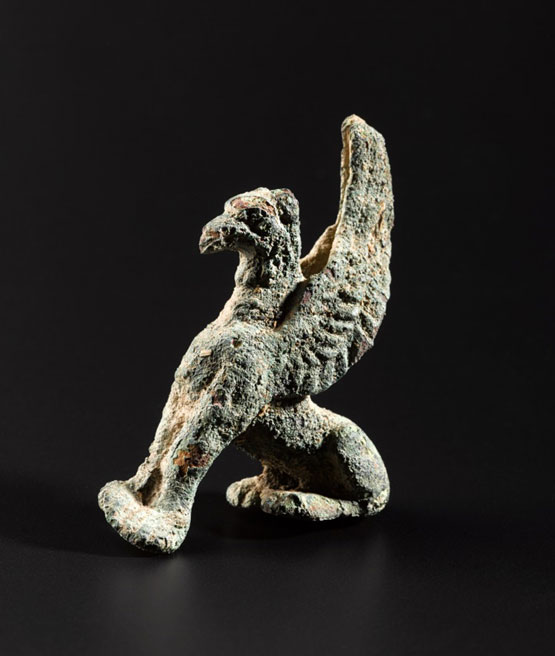
But some real creatures were also considered fantastic to people in Scotland. The lion, as a Christian symbol of the Gospel writer St Mark, appears on a bronze Christian book mount found in a Viking grave from Westness, Orkney [Q8]. It is barely recognisable as a lion, but this is understandable when people living in Scotland would have never seen such exotic creatures.

In the third gallery section, Them and Us (colour-coded purple), we see how earlier Celtic art made fantastic beasts out of animals that would have been familiar, such as the native wild boar. The craftsperson who made the Deskford carnyx [R7] was not interested in making this boar-headed war-horn look realistic – they wanted it to look fantastic as it brayed out a spine-tingling noise during battle.
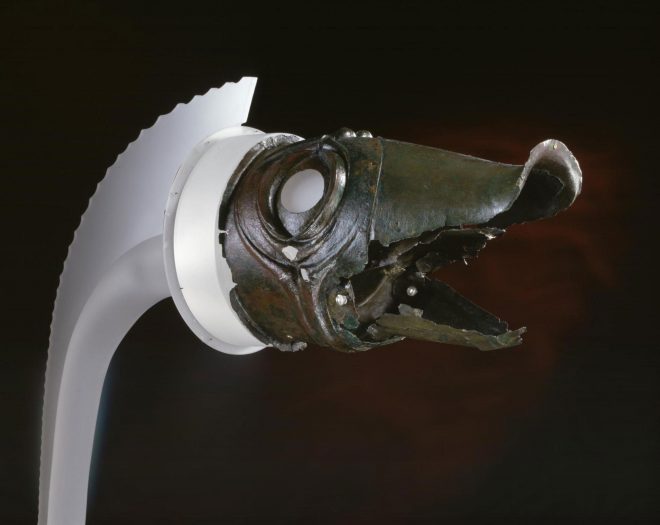
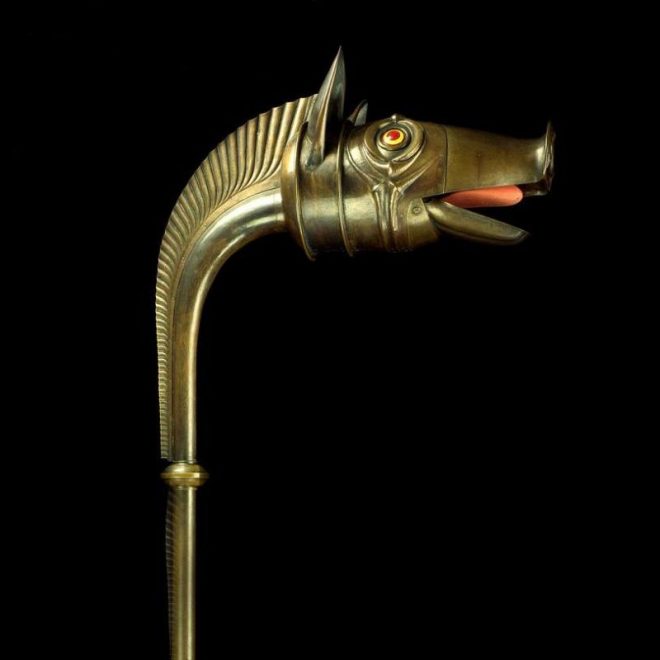
More fantastic still is the Torrs pony cap [V3], found in Kirkcudbrightshire. This was worn by a horse or pony, but elaborately decorated and with slender curved horns transforming this everyday creature into something otherworldly.
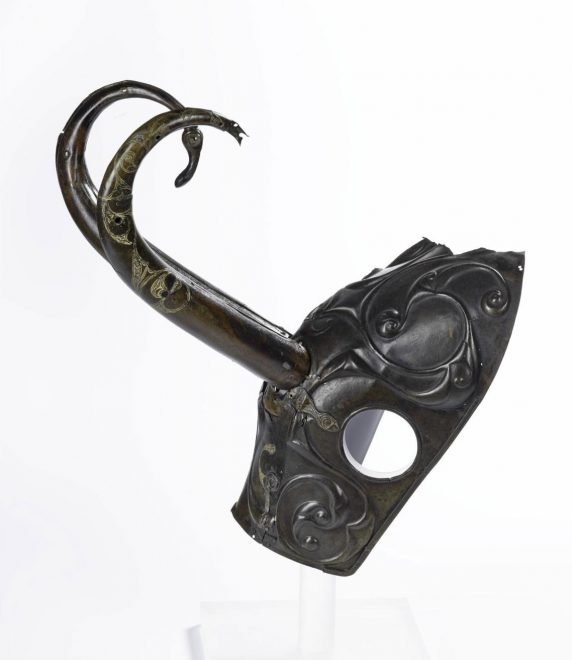
On later metalwork, fantastic beasts tell us about the variety of people and mythologies that came to Scotland during the early medieval period. If you look very closely at the Hunterston brooch [V7] you will see a variety of creatures depicted at a minute scale using the finest gold-working technology using tiny gold balls and wire.
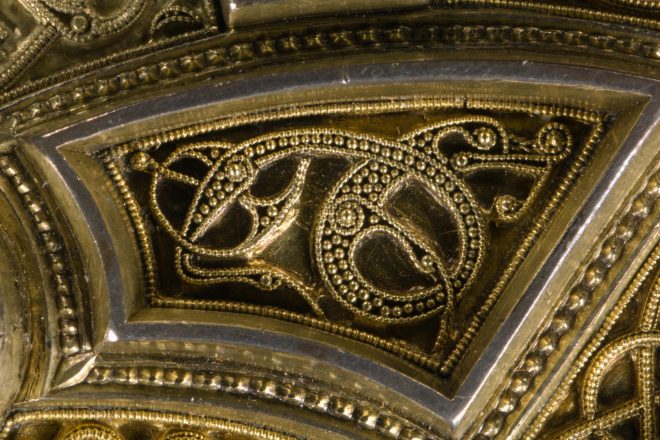
These came from the imaginations of Anglo-Saxon people who arrived in Britain as Roman influence declined in the fifth century AD. Five centuries later, the densely coiled creatures on the ball terminal of the large Viking-Age silver brooch from the hoard found at Skaill, Orkney [U1] came to Scotland from Scandinavia.
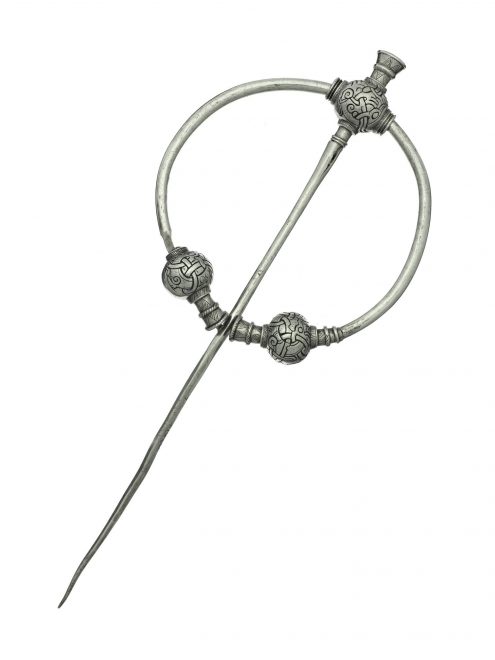
In the final section of the Early People gallery, In Touch with the Gods (colour-coded grey), a Roman burial monument called the Cramond lioness [W8] looks fairly realistic as the exotic animal ferociously devours a human.
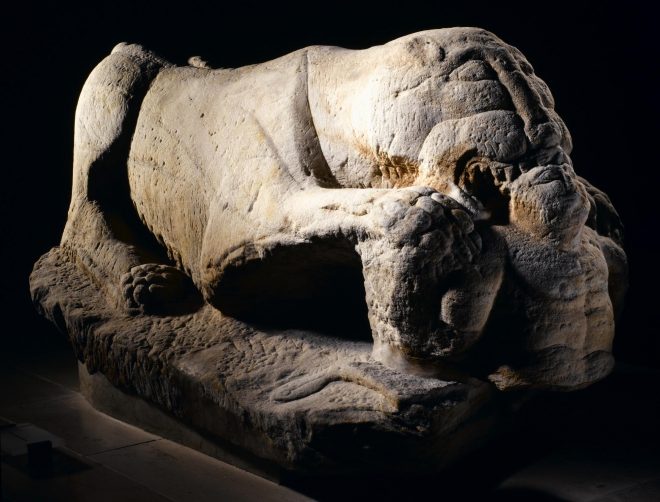
Again, surprisingly, it is in Early Christian art that we see some of the most fantastic beasts from the fertile imagination of the Picts. One top corner of the cross-slab from Woodwray [Y22] has been interpreted as a Bible story, Jonah and the Whale or the Book of Job, but this is no realistic whale – it is a Leviathan with a serpent’s tail, swallowing a man whole.
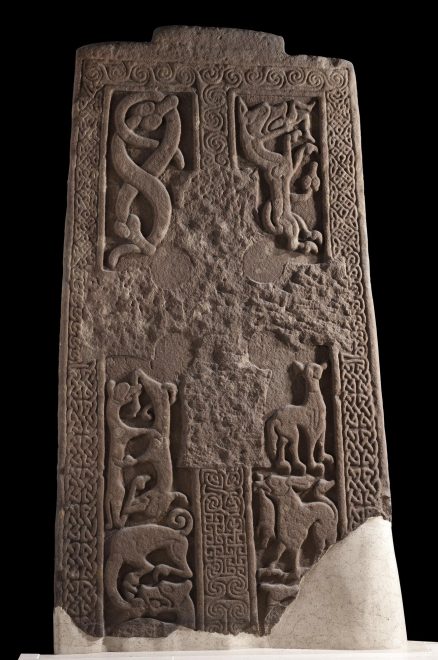
As shown in the first part of the gallery, A Generous Land, whales and especially whale-bone were important practical resources for Early People, but these were also fantastic beasts of the watery deep. Amongst the treasures of the St Ninian’s Isle hoard [Y23] is the jawbone of a porpoise, stained green with copper from the other metal artefacts. What was it doing with all of these precious objects? It must surely have had some value itself. Was it treasured because it was considered to be a fantastic beast?
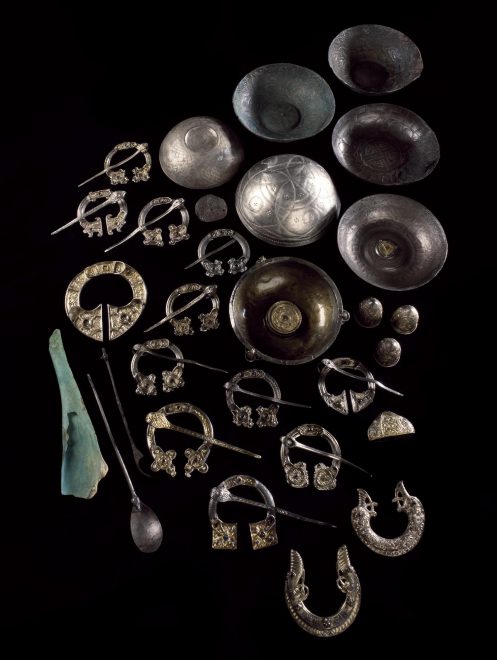
Sometimes the fantastic beasts on early medieval brooches were not minute and virtually hidden, but were still intended to be seen best by those who wore them. The terminals on this St Ninian’s Isle brooch look upside-down to us viewing them, but would have looked correct to the person looking down at it pinned to their cloak, admiring themselves.
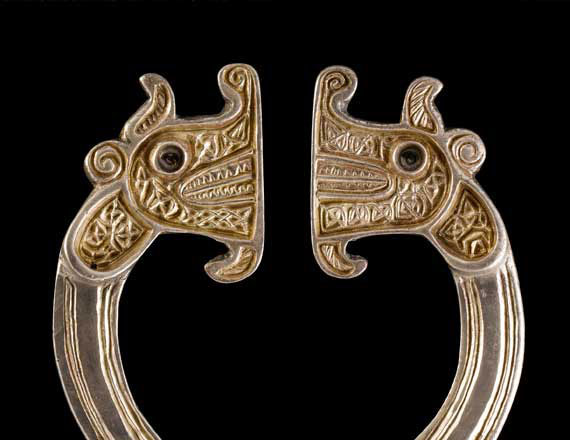
The cross-slab from Papil, Shetland [Y25] has another almost unrecognisable lion, but even more unreal are the two bird-headed creatures with a human head between their beaks.
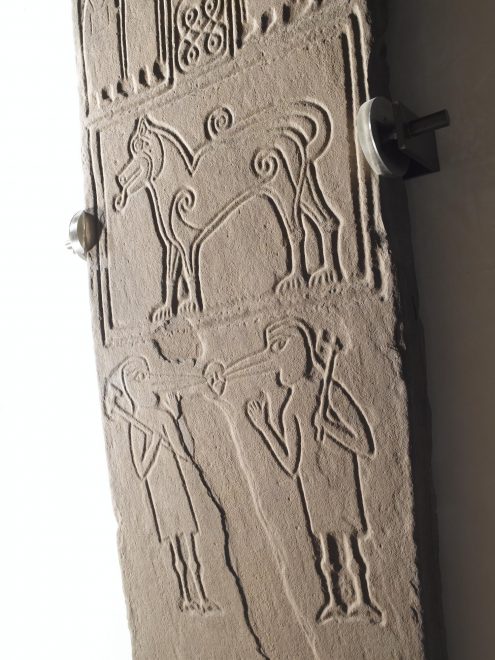
What these meant on an otherwise clearly Christian monument is a mystery. They are not unique though. The sculpted stone panel from Gellyburn, Perthshire [Y25] has two armed, dog-headed humanoids and a pair of half-horse half-fish hippocamps. There is also a fantastic beast, perhaps a crocodile, although it has a fish-like tail.
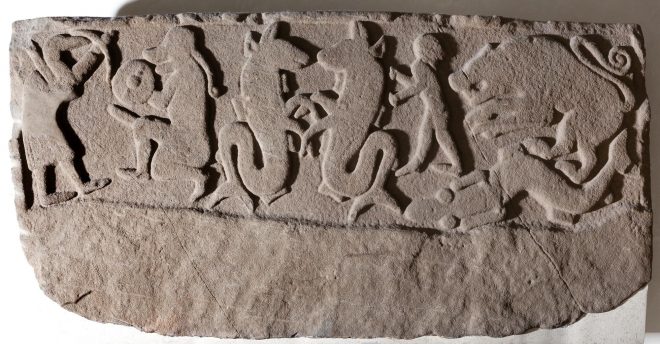
It is often difficult to say where Early People’s fantastic beasts came from or what they thought about them, but now at least you know where to find them. Good hunting.
